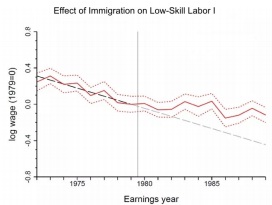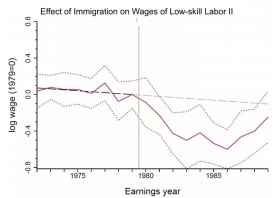Assignment:
In 1980, Fidel Castro, then Cuba's president, invited Cubans who wished to leave to do so, provided they left through Cuba's Mariel harbor. Between May and September, a flotilla of vessels (called the Mariel Boat-lift) transported about 125,000 Cubans from Mariel to Miami, resulting in a significant (7 - 8%) increase in the supply of labor in Miami.
The model of Demand and Supply that you have recently studied implies that, other things constant, an increase in the Supply of a good or service ought to result in a decrease in its price. That is, when the Supply of Labor rises, all else remaining the same, we expect to see a decrease in the equilibrium wage in the relevant Labor market. In this case, the relevant labor market is that for Unskilled Labor, since only about half of the new Cuban immigrants had a high school degree. There is a broiling controversy over what actually happened.
The graph below is from an article by Micheal Clemens, published by Vox on July 27, 2017 entitled, There's no evidence that immigrants hurt any American workers.

The solid red line tracks the average wage for Unskilled workers in Miami for a period spanning the 1980 influx of immigrants (from the early 70's through 1987.) The dotted red lines indicate the confidence interval around that average. That is, due to the uncertainty in our measurements, the actual average wage in any given year could be as high as the top dotted line or as low as the bottom dotted line. The amount of uncertainty and thus, the width of that confidence interval, depends on the number of people in the sample. The 1 bigger the sample, the more certain the measurement. The gray dashed line shows what the average wage would have been had the pre-1980 trend continued after 1980.
The graph below shows that average wages of low-skill labor in Miami actually rose after the wave of immigration - the opposite of the expected effect. The graph below, from the same article, shows a very different pattern.

The pattern in the first graph was reported by economists Giovanni Peri and Vasil Yasenov in a 2015 study. The second graph reflects the pattern found in a 2017 article by George Borjas. In the words of Michael Clemens, "In short, different well-qualified economists arrive at opposite conclusions about the effects of immigration, looking at the same data about the same incident, with identical modern analytical tools at their disposal."
Writing Prompt
According to article, There's no evidence that immigrants hurt any American workers
1. What accounts for the difference between Peri and Yasenov's conclusion and Borjas' conclusion? Thoroughly discuss the various factors that influenced the results of those two studies.
2. Why does Michael Clemens claim that even if no ones wage actually changed, George Borjas' data would nevertheless have shown a decrease in the average wage after 1980?